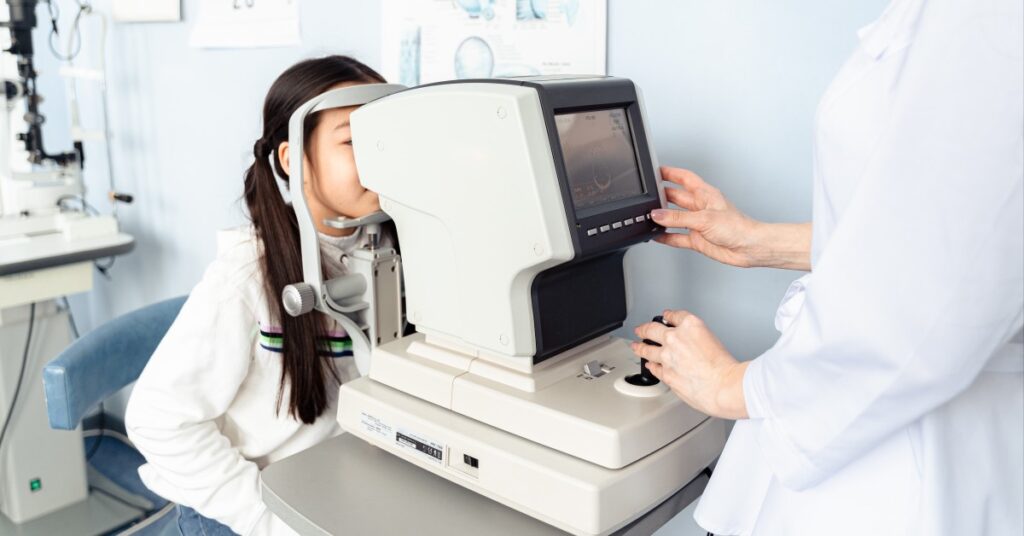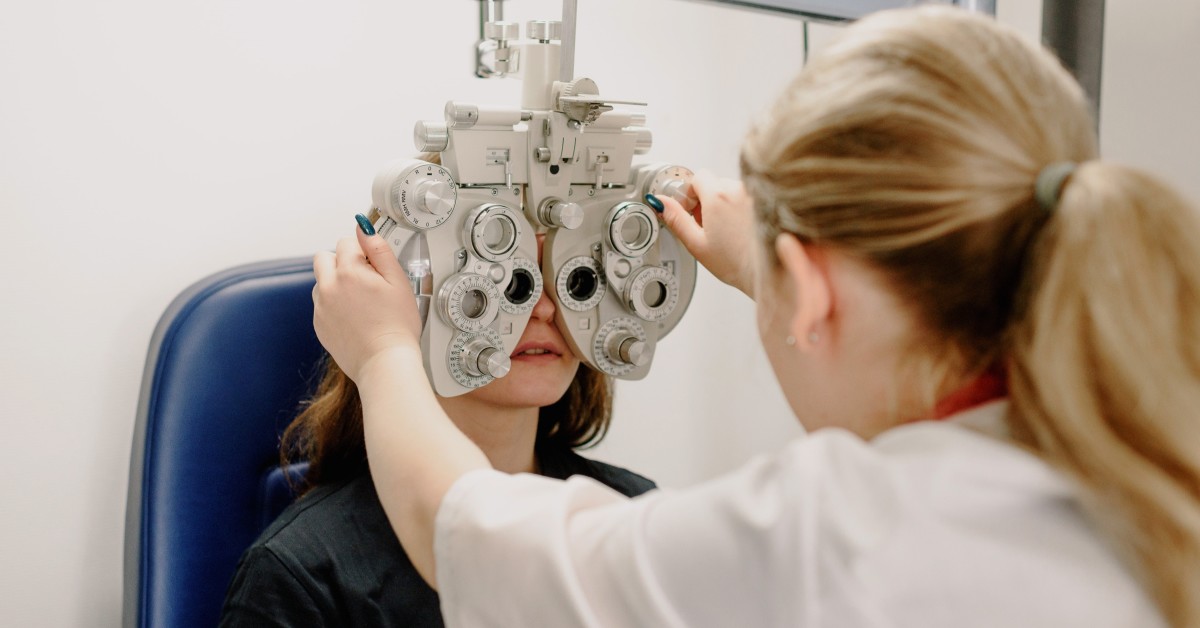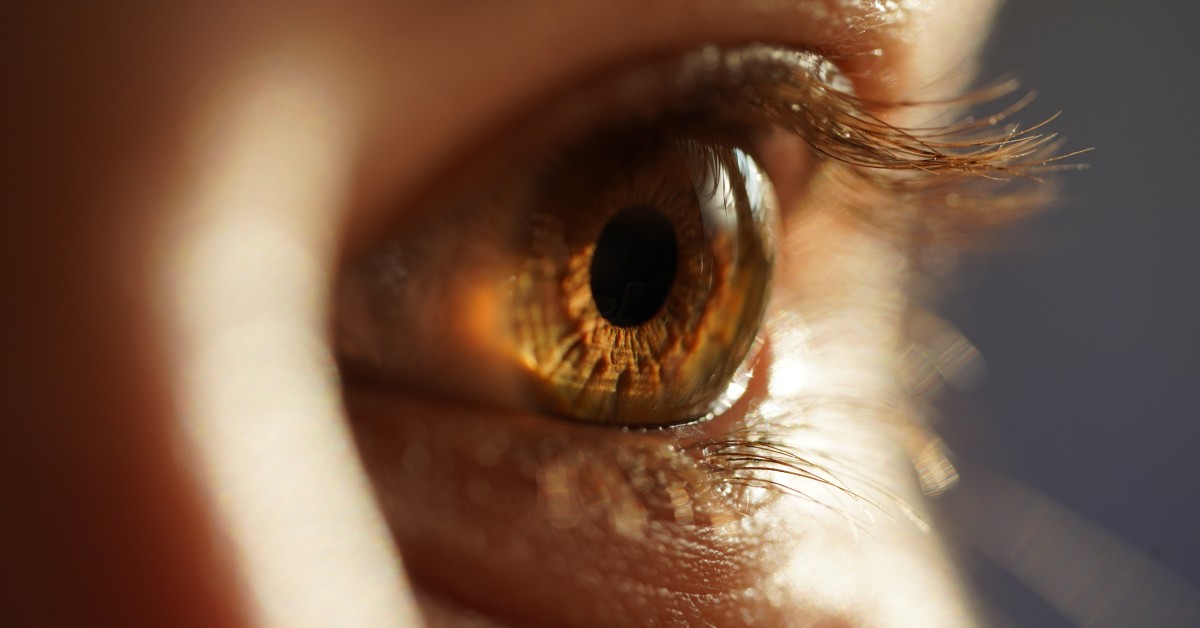
Why Become a Sports Vision Optometrist?
Sports vision optometrists work with patients at all levels, including [...]

Children spend an average of 7.5 hours per day looking at screens. Psychologists may debate the impact of this particularly 21st-century phenomenon on children’s social and intellectual development, but its effect on children’s eye health is quantifiable and undeniable. All those hours of staring into a bright light can cause harmful eye strain.
Educating children and their parents about the impact of too much screen time is just one of many tasks undertaken by pediatric optometrists. These professionals work with youngsters to conduct consultations and assessments, diagnose common eye problems, prescribe remedies, and offer recommendations to pediatric ophthalmologists when surgical interventions are deemed necessary. With jobs for optometrists projected to grow by 10 percent between 2021 and 2031, the time is right to consider optometry as a meaningful career option. If working with kids is among your career objectives, pediatric optometry is likely the field for you.
Why become a pediatric optometrist? This article delves into that question. It also examines:
Pediatric optometrists perform many of the same duties as generalists do, but with a focus on young people. Studies suggest that human learning is 80 percent driven by visual stimuli. Data also indicate that one in four K-12 students experience vision issues that could impede learning. Eye care is always important, but it is especially so during this critical formative period.
If that mission call isn’t sufficient, know also that the workforce currently suffers a shortage of optometrists focused on patients aged 18 and under, a group that currently accounts for approximately 25 percent of the U.S. population. Becoming a pediatric optometrist means entering a field that is currently ripe with opportunities.
Imagine a day in the life of an adult optometrist. Then add finger puppets and crayons, and you have some idea about the daily duties of a pediatric optometrist. Providing regular eye examinations and diagnosing common eye diseases, pediatric optometrists stop short of performing eye surgery; for that, they refer patients to ophthalmologists focused on children’s care.
Treating eye problems in children differs in important ways, especially when it comes to conducting vision tests and identifying the types of eye conditions commonly diagnosed. In the case of younger children who have not yet learned to read or non-verbal children, optometrists must use different metrics to determine vision clarity. For instance, a pediatric optometrist may use common shapes or children’s toys to ascertain how well a child can see.
When dilation is required, optometrists can opt for a different type of eye drop that typically does not sting. Working with children, especially younger ones, may also mean a faster examination to account for their shorter attention span.
Pediatric optometrists commonly perform functional eye exams to help identify any vision issues contributing to learning difficulties. Issues of nearsightedness, farsightedness, amblyopia, or strabismus typically result in prescribing eyeglasses that are either worn full-time or during set periods to help correct problems. While optometrists can diagnose more serious issues such as retinoblastoma or tumors, they typically refer these patients to pediatric ophthalmologists for more specialized medical eye care.
Becoming a pediatric optometrist requires a commitment to education. Most optometrists spend at least eight years in post- secondary study, plus an extra year if they choose to develop a specialization. Preparation begins with an undergraduate degree, typically in biology, physical science, or another medical-related field. Choosing this path benefits students who know they want to become optometrists; it enables them to complete prerequisites for Doctor of Optometry (OD) programs and prepare for the OD program admission exam.
Some OD options allow learners who have completed at least 90 undergraduate credits (and all required prerequisites) to gain early admission and bypass the final year of their bachelor’s degree. After completing all OD requirements, graduates can participate in a year-long residency to develop pediatric-specific optometry skills. Individuals must also pass the National Board of Examiners in Optometry examination and any other examinations required in their state before receiving licensure.
Most Doctor of Optometry programs require four years of full-time study.
Every school sets individual admission requirements, though many overlap. For instance, all schools require GPAs but some may look for candidates with higher averages than others. All 23 Doctor of Optometry programs throughout the United States use the Optometry Centralized Application Service (OptomCAS) to ease the process for candidates considering multiple schools. OptomCAS functions similarly to the CommonApp used for undergraduate admissions.
When using OptomCAS, students upload transcripts demonstrating completion of all prerequisites, recommendation letters, a personal essay, and answers to all application questions. If required, students must also upload scores from the Optometry Admission Test (OAT) or Graduate Record Examination (GRE). Some schools have relaxed standardized test requirements in recent years, so check individual program requirements. Students must also submit application fees to each program.
DO programs are divided across four years of study, with each year focusing on different skills and competencies. At the New England College of Optometry, students can expect the following:
All 50 states require pediatric optometrists to hold licensure through their local board. To acquire licensure, applicants must pass a multi-part examination offered through the National Board of Examiners in Optometry. Some states may also require applicants to pass additional clinical or legal exams before being licensed. To continue practicing, pediatric optometrists must undertake continuing education each year and reapply for licensure as required.
While specific salary figures for pediatric optometrists does not exist via the Bureau of Labor Statistics, we know that generalist optometrists earned median incomes of $124,300 as of May 2021. Factors such as how much experience an optometrist possesses, their title, where they live, and where they work can all affect earnings. For instance, optometrists who own their practice typically earn more than those who work for a clinic or hospital. The top 10 percent of these professionals received salaries of more than $192,390 during the same year. The job posting website Salary.com reports pediatric optometrists’ average annual salary at just over $113,000, with the top 10 percent earning over $136,000 per year.
As of October 2022, none of the 23 doctor of optometry degrees in the US offer fully online programming. Last year, the New England College of Optometry (NECO) became the first school in the nation to develop a hybrid program. Slated to welcome its first students during the fall 2023 academic term, the program plans to partner with clinical sites across the country to allow learners to remain in place while working towards their doctoral education. Meanwhile, coursework will be completed online. Given that 33 states currently have no OD programs, NECO’s offering should provide greater access to education and, consequently, pediatric optometry care.
.
Questions or feedback? Email editor@noodle.com

Sports vision optometrists work with patients at all levels, including [...]

Cornea and contact lens optometrists are highly educated practitioners; they [...]

Forensic optometrists employ optometric science to assist the police in [...]

Optometrists conduct eye exams that detect not only myopia, glaucoma, [...]

Ocular disease optometrists specialize in the early detection, diagnosis, and [...]
Categorized as: Optometry, Nursing & Healthcare